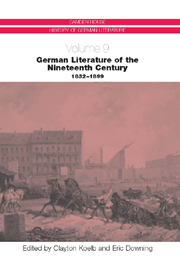Book contents
- Frontmatter
- Contents
- Illustrations
- Introduction
- Part I Contexts
- Part II Movements
- Literary Controversy: Naming and Framing the Post-Romantic, Pre-Realist Period
- Poetic Realism, Naturalism, and the Rise of the Novella
- Literary Movements of the 1890s: Impressionism, Symbolism, and fin-de-siècle Austria
- Part III Genres
- Part IV Bibliographical Resources
- List of Primary Sources
- Selected Secondary Works Cited
- Notes on the Contributors
- Index
Poetic Realism, Naturalism, and the Rise of the Novella
from Part II - Movements
Published online by Cambridge University Press: 05 February 2013
- Frontmatter
- Contents
- Illustrations
- Introduction
- Part I Contexts
- Part II Movements
- Literary Controversy: Naming and Framing the Post-Romantic, Pre-Realist Period
- Poetic Realism, Naturalism, and the Rise of the Novella
- Literary Movements of the 1890s: Impressionism, Symbolism, and fin-de-siècle Austria
- Part III Genres
- Part IV Bibliographical Resources
- List of Primary Sources
- Selected Secondary Works Cited
- Notes on the Contributors
- Index
Summary
Introduction
As a stylistic mode, realism has long been with us. For Aristotle, whose Poetics (fourth century B.C.) remained the bible of dramatic theory in the West for more than 2000 years, the arts, including literature, are based on imitation, or mimesis. This definition yields the criterion of verisimilitude, or trueness to life, which is equivalent to realism in its most general sense: the truer a work of art is to nature — the more faithful the artistic imitation — the more realistic the work is. This criterion can be applied to texts of any period and genre, although it is of course far from absolute or objective, since verisimilitude can lie in the eye of the beholder.
Realism as a diachronically universal stylistic mode reaches a synchronic high point in the nineteenth century, when it acquires the status of a historical period or movement. At this time its definitions become numerous and complex. In this chapter they will be seen to crystallize around three principal dichotomies:
1) Realism as a nineteenth-century movement vs. realism as a timeless stylistic mode; I will designate these as “Realism” and “realism,” respectively.
2) Realism in non-German-speaking countries, above all, France, England, and Russia (referred to in this chapter as “European Realism”) vs. Realism in Germany, Switzerland, and Austria, often known as Poetic Realism.
3) Realism vs. naturalism.
Two of the first critics to confront these dichotomies systematically are Erich Auerbach and Georg Lukács.
- Type
- Chapter
- Information
- German Literature of the Nineteenth Century, 1832–1899 , pp. 117 - 138Publisher: Boydell & BrewerPrint publication year: 2005



